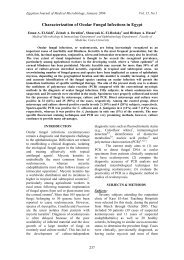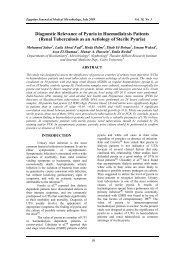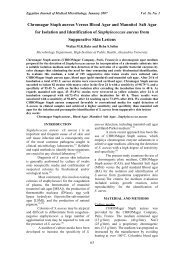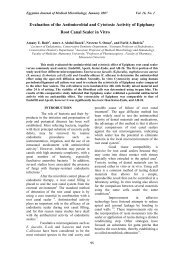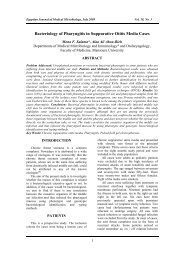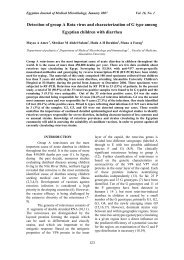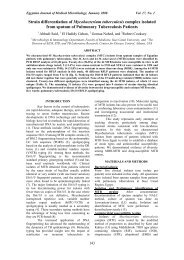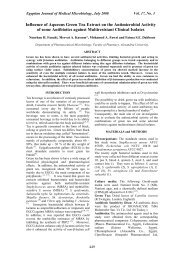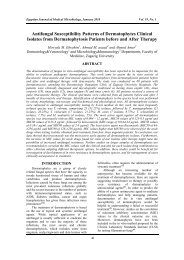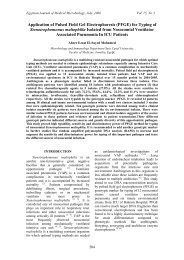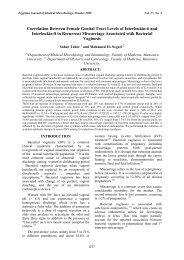Diagnostic Value of Tuberculin Test, Adenosine Deaminase and ...
Diagnostic Value of Tuberculin Test, Adenosine Deaminase and ...
Diagnostic Value of Tuberculin Test, Adenosine Deaminase and ...
Create successful ePaper yourself
Turn your PDF publications into a flip-book with our unique Google optimized e-Paper software.
Egyptian Journal <strong>of</strong> Medical Microbiology, April 2008 Vol. 17, No. 2<strong>Diagnostic</strong> <strong>Value</strong> <strong>of</strong> <strong>Tuberculin</strong> <strong>Test</strong>, <strong>Adenosine</strong> <strong>Deaminase</strong> <strong>and</strong>Polymerase Chain Reaction in Tuberculous <strong>and</strong> non tuberculousPleural EffusionMona Abdel monem Esmail*, Hala Abdel Hameed**, Salama Rabea***,YehiaShaker **** Atef Elakad***** Microbiology <strong>and</strong> Immunology**Chest, *** Bio Chemistry <strong>and</strong> ****Internal Medicine Department,Faculty <strong>of</strong> Medicine, Minia University.ABSTRACTBackground: Tuberculosis (TB) is a major cause <strong>of</strong> pleural effusion, which in TB usually haslymphocytic <strong>and</strong> exudative characteristics. The final diagnosis <strong>of</strong> TB pleurisy was based on combining clinicaljudgment with radiological findings, <strong>and</strong> microbiologic tests, In cases <strong>of</strong> suspected pleural tuberculosis, a rapid<strong>and</strong> accurate laboratory diagnosis through ADA activity <strong>and</strong> PCR detection is <strong>of</strong> prime importance, sincetraditional techniques <strong>of</strong> detecting acid- fast bacilli have limitations.Aim <strong>of</strong> the work: To examine the diagnostic efficiency <strong>of</strong> Ziehl-Neelsen (Z.N) staining, tuberculin test, ADAactivity, <strong>and</strong> PCR in patients with pleural effusions <strong>and</strong> related the results to clinical signs <strong>and</strong> symptoms in apopulation with a high prevalence <strong>of</strong> TB.Patients: The study included 92 patients with pleural effusion <strong>of</strong> different etiologies taken from ChestDepartment, Minia University Hospital <strong>and</strong> Minia Chest Hospital between July <strong>and</strong> 2007 <strong>and</strong> March 2008.The diagnosis <strong>of</strong> pleural (p) TB was confirmed in any patient presenting with positive findings <strong>of</strong>Mycobacterium tuberculosis, either on the sputum or pleural fluid <strong>and</strong> also, in the absence <strong>of</strong> negativelaboratory results, those patients with clinical improvement after empirical treatment.Methods: A single specimen <strong>of</strong> pleural fluid (50to100ml) was submitted for appearance, <strong>and</strong> protein content,Ziehl-Neelsen staining, pleural ADA activity determination <strong>and</strong> PCR .Also 10 ml blood for estimation <strong>of</strong>hemoglobin, ESR <strong>and</strong> serum ADA activity. The sputum was examined for acid fast bacilli by Z.N. staining.Results: Out <strong>of</strong> 92 cases studied there were 40 cases (43%) <strong>of</strong> highly suspicious <strong>of</strong> tuberculous pleural effusion.Examination <strong>of</strong> pleural effusion by Z&N stain in all cases was negative. On the other h<strong>and</strong>, +ve PCR wasfound only in 16 cases (40 %) <strong>of</strong> TB pleural effusion <strong>and</strong> 3 cases <strong>of</strong> empyema. All 40 cases <strong>of</strong> tubercular pleuraleffusion showed greatly significant elevated ADA levels in pleural fluid, with a mean value <strong>of</strong> 57.4±7.7 U/L incomparison with other nonTB pleural effusion ADA levels including 25 cases <strong>of</strong> Para pneumonic effusionswith a mean value <strong>of</strong> 27.5 ± 9 U/L., 7 cases <strong>of</strong> empyema with a mean value <strong>of</strong> 24.8 ± 3 U/L, <strong>and</strong>, <strong>of</strong> 18.5 ± 6.5U/L was the mean value <strong>of</strong> pleural fluid ADA among cases <strong>of</strong> liver cell failure. A significant +ve. correlationwas observed between sputum examination by ZN <strong>and</strong> tuberculin test, <strong>and</strong> PCR in TB pleural effusion group(p
Egyptian Journal <strong>of</strong> Medical Microbiology, April 2008 Vol. 17, No. 2permeability <strong>and</strong> secondarily from impairment <strong>of</strong>lymphatic clearance <strong>of</strong> proteins <strong>and</strong> fluid from thepleural space because <strong>of</strong> occlusion <strong>of</strong> pleuralstomata (11) .In contrast, reactivation disease isfrequently associated with parenchymal lesions.(10) (1).TB pleural effusion was considered a disease <strong>of</strong>the young, with a mean age <strong>of</strong> 28 years, comparedto 54 years for parenchymal tuberculosis (12)However, in recent years, several authors reportedthat mean patient age has gradually risen (13) <strong>and</strong>that tuberculous pleurisy is becoming apredominantly reactivated form <strong>of</strong> tuberculosis, atleast in industrialized nations.Diagnosis <strong>of</strong> pulmonary tuberculosis isconfirmed mainly by sputum examination <strong>of</strong> AFB.However, the diagnosis <strong>of</strong> extra pulmonarytuberculosis requires investigation <strong>of</strong> pleural fluidbiochemistry, cytology <strong>and</strong> pleural biopsy.Positivity <strong>of</strong> AFB <strong>and</strong> Histopathological (HP)study <strong>of</strong> pleura is very low <strong>and</strong> culture is very timeconsuming. ELISA, PCR & Interferon are veryexpensive tests. <strong>Adenosine</strong> deaminase has beenproposed to be a useful surrogate marker fortuberculosis in pleural, pericardial <strong>and</strong> peritonealfluids.(14)ADA is an enzyme in the purine salvage pathwaythat catalyzes the conversion <strong>of</strong> adenosine <strong>and</strong> deoxyadenosineto inosine <strong>and</strong> deoxyinosine withthe release <strong>of</strong> ammonia. Although ubiquitous indistribution, it plays an important role indifferentiation <strong>of</strong> lymphoid cells <strong>and</strong> is mostabundant in lymphocytes (predominantly active T-lymphocytes) whose concentration is inverselyrelated to the degree <strong>of</strong> differentiation.(15).Studies have confirmed high sensitivity <strong>and</strong>specificity <strong>of</strong> adenosine deaminase for earlydiagnosis <strong>of</strong> extra pulmonary tuberculosis (14).The aim <strong>of</strong> the work:It was to examine the diagnostic efficiency <strong>of</strong>conventional, (Z.N staining <strong>and</strong> tuberculin test)<strong>and</strong> alternative diagnostic methods (ADA activity<strong>and</strong> PCR) in patients with tuberculous pleuraleffusions individually <strong>and</strong> in combination <strong>and</strong>related the results to clinical signs <strong>and</strong> symptomsin a population with a high prevalence <strong>of</strong>TB.Subsequently, we determined the sensitivity,specificity, positive predictive values (PPVs) <strong>and</strong>negative predictive values (NPVs) <strong>of</strong> each methodin patients with pleural effusions.PATIENTS AND METHODSPatientsThe study included 92 patients with pleuraleffusion seen in Chest Department, MiniaUniversity Hospital <strong>and</strong> Minia Chest Hospitalbetween July <strong>and</strong> 2007 <strong>and</strong> March 2008.Clinicalsymptoms <strong>and</strong> signs, demographic data <strong>and</strong>radiological results were recorded. The response tointradermal purified proteins derivative (PPD) wasevaluated, <strong>and</strong> an induration <strong>of</strong> >10 mm wasconsidered to be positive result.The following four groups were evaluated:1-Group 1 pleural TB (40 cases)2-Group 2 Para pneumonic effusions (25 cases)3-Group 3 empyema (7cases)4- Group 4 pleural effusions due to liver cellfailure (20 cases)Case Definition <strong>of</strong> TuberculosisCases <strong>of</strong> pTB were defined as those patients withclinical manifestations suggestive <strong>of</strong> tuberculosis,i.e. the presence <strong>of</strong> productive cough, low-gradefever, night sweats, weight loss, <strong>and</strong> chest pain,especially if these symptoms lasted 4 weeks <strong>and</strong>presenting with a positive Ziehl-Neelsen result, insputum <strong>and</strong> or the pleural fluid .Patients withclinical <strong>and</strong> radiological findings that lackedmicrobiological confirmation but respondedpositively to empirical anti TB therapy were alsoconsidered to be tuberculosis cases. We defined apositive response to therapy as the improvement<strong>of</strong> clinical <strong>and</strong> radiological findings after 2 months<strong>of</strong> the therapy.Laboratory methodsA single specimen <strong>of</strong> pleural fluid (50to100ml)was submitted for appearance, examinationprotein content, Ziehl-Neelsen staining, pleuralADA activity determination <strong>and</strong> PCR Also 10 mlblood for estimation <strong>of</strong> hemoglobin, ESR <strong>and</strong>serum ADA activity. Pleural fluid samples wereconcentrated by centrifugation for 20 min at10.000g at4ْ C. The pellet was resuspended in 1.5 mlDNAse-free buffer (PH, 8.0).The sputum wasexamined for acid fast bacilli by Z.N. staining.<strong>Tuberculin</strong> skin test was also done.<strong>Adenosine</strong> deaminase assay in serum <strong>and</strong>Pleural effusion:Assay procedure:The ADA assay kit was obtained fromDIAZYME. Serum <strong>and</strong> pleural effusion sampleswere analyzed <strong>and</strong> monitored kinetically for 10minutes at 550 nm (16)Principle <strong>of</strong> assay:The ADA assay is based on the enzymaticdeamination <strong>of</strong> adenosine to inosine which isconverted to hypoxanthine that converted to uricacid by xanthine oxidase <strong>and</strong> H 2 O 2 generated usedto monitor assay kinetically at 550 nm.DNA Extraction <strong>and</strong> PCR:50µl pleural fluid was added to a sterile1.5 mlmicr<strong>of</strong>uge tube containing 250µl Cell LysisSolution then it was incubated at65 ْc for 15 minutes to complete lysis. 1.5 µlRNase A Solution was added to the cell lysate.The sample was mixed by inverting the tube 25times <strong>and</strong> was incubated at 37 ْc for 15-60 minutes.288
Egyptian Journal <strong>of</strong> Medical Microbiology, April 2008 Vol. 17, No. 2It was cooled to room temperature.100 µl ProteinPrecipitation Solution was added to the lysate, wasvortexed, was placed into an ice bath <strong>and</strong> wascentrifuged at 13.000-16.000 xg for 3 minutes.The precipitated proteins formed a tight pellet.The supernatant containing the DNA (leavingbehind the precipitated protein pellet) was pouredinto a clean 1.5 ml micr<strong>of</strong>uge tube containing300µl 100% Isopropanol.0.5 µl Glycogen Solution was added per 300 µlIsopropanol.The sample was mixed by inverting gently 50times <strong>and</strong> was incubated at room temperature forat least 5 minutes. The sample was centrifuged at13.000-16.000 xg for 5 minutes. The supernatantwas poured <strong>of</strong>f <strong>and</strong> tube was drained briefly onclean absorbent paper. 300 µl 70%Ethanol wasadded <strong>and</strong> the tube was inverted several times towash the DNA pellet. The tube was centrifugedfor 1 minute. The tube was inverted <strong>and</strong> drainedon clean absorbent paper <strong>and</strong> was allowed to airdry10-15 minutes. 10 µl <strong>of</strong> DNA HydrationSolution was added. DNA was rehydrated byincubating sample for one hour at 65ْC. Tube wasvortexed <strong>and</strong> DNA was stored at 4ْC (17) (18)(Gentra, USA)Thermal cycling parametersA st<strong>and</strong>ard three step endpoint PCR cyclingprotocol consists <strong>of</strong> multiple cycles <strong>of</strong>denaturation(95ْ C),annealing(40-60ْC) <strong>and</strong>extension(72ْ C ).An initial denaturation step (95ْ Cfor 5 min) is recommended to ensure completedenaturation <strong>of</strong> the template DNA. In some cases,it may be possible to amplify a target sequenceusing two –step PCR, the denaturation step(95ْC)is followed by a combined annealing/elongationstep(50-65ْ C). For most st<strong>and</strong>ard, three-stepPCRs, 35 cycles produce5 9a 10 -10 fold amplification <strong>of</strong> the target sequence.PCR product yield can be improved by increasingthe number <strong>of</strong> cycles to 40 (19)(20) (AmershamBiosciences, Engl<strong>and</strong>).Thereafter Gel was prepared with 2% agarose gel.The samples were placed in the gel chambers, <strong>and</strong>then power was supplied on 105 volt for1 hours.Finally, the b<strong>and</strong>s were detected by UV lamp (Fig:3).Statistical analysis:Data were coded, entered <strong>and</strong> analyzed by SPSSpackage version 13.0.under windows. Mean,st<strong>and</strong>ard deviation, frequency distribution <strong>and</strong>cross tabulation were estimated for study groups.<strong>Test</strong>s <strong>of</strong> significance used during comparisonamong study groups were one-way ANOVA forquantitative data <strong>and</strong> Chi-square test forcategorical data. Pearson correlation coefficientwas to correlate between; correlation coefficientwas to correlate between quantitative data whileSpearman correlation coefficient was to correlatebetween categorical data. P value <strong>of</strong>
Egyptian Journal <strong>of</strong> Medical Microbiology, April 2008 Vol. 17, No. 2Table 2: Comparison between groups regarding laboratory data:laboratory data:TB pleuraleffusion(n= ٤٠)Parapneumonic(n= ٢٥)Empyema(n= 7)Liver cellfailure(n= 2٠)Total(n=92)<strong>Test</strong>P<strong>Tuberculin</strong>testZNsputumRange 15-18 6-14 6-11 8-10 6-18Mean ± SD 16.2±1.2 9.6±3.4 9.14±1.57 9.2±0.76 12.4±3.9+ve 5( 12.5%) 0 0 0 5(5.4%)-ve 35(87.5%) 25(100%) 7(100%) 20(100%) 87(94.6%)F=83.20.0001F=38.1 0.07PCRPositive 16(40%) 0(0%) 3(42.8%) 0(0%) 19(20.6%)Negative 24(60%) 25(100%) 4(57.2%) 20(100%) 73(79.4%)X 2 =22.950.0001ADA effusionRange 48-65 19-40 19-28 14.7-31 14.7-65Mean ± SD 57.4±7.7 27.5±9 24.8±3 18.5±6.5 38.3±18.6F=152.380.0001ADA serumRange 24-53 12-22 14-20 22-26 12-53Mean ± SD 37.4±9.4 17.7±3.4 18.9±2.3 24.2±1.9 27.8±10.9F=54.570.0001HbRange 9-12.5 8.5-10.5 12.5-12.5 9-11 8.5-12.5Mean ± SD 10.6±1.2 9.6±0.8 12.5±0 ±0.7١٠٫٢ 10.4±1.2F=9.160.0001ESR1stRange 60-106 60-100 47-63 60-95 47-106Mean ± SD 89.6±16.3 77.6±17.7 56.4±5.7 75±16.9 80.64±18.6F=10.230.00012ndRange 105-126 68-90 62-72 50-90 50-126Mean ± SD 110.2±8.24 79.8±9.24 69±4.3 68.4±18.6 89.7±21.6F=80.60.0001Table 3: Statistical analysis <strong>Tuberculin</strong> test (TT) readings in p TB effusionP(TT) Sensitivity Specificity Positive Pred.Cut<strong>of</strong>f point%%value %Negative Pred.value %>6>8>9100.00100.00100.0017.3125.0061.5448.250.666.7100.0100.0100.0>10>11>14 *>15>16>17>18100.00100.00100.0060.0040.0020.000.0080.7782.69100.00100.00100.00100.00100.0080.081.6100.0100.0100.0100.00100.0100.0100.076.568.461.956.5291
Egyptian Journal <strong>of</strong> Medical Microbiology, April 2008 Vol. 17, No. 2230 pb<strong>of</strong> isolatedb<strong>and</strong>23 4 5 6 7 81100 pbla d d e rFig .3. Lane1 is 100 pb ladder. Lane2 is the-ve control. Some positive samples employ lanes 3-8.1.00.75.50Sensitivity.250.00ADA serumADA pleural fluid<strong>Tuberculin</strong> test0.00.25.50.751.001 - SpecificityFig 1: Roc curve in tuberculus pl. effusion group at the best cut <strong>of</strong>f1.00.75.50Sensitivity.250.00ADA serumADA pleural fluid<strong>Tuberculin</strong> test0.00.25.50.751.001 - SpecificityFig 2: Roc curve in non tuberculous group (n=52) at the best cut <strong>of</strong>f293
Egyptian Journal <strong>of</strong> Medical Microbiology, April 2008 Vol. 17, No. 2pleural fluid with a mean value <strong>of</strong> 57.4±7.7 U/Lit<strong>and</strong> were significantly raised compared to othercases <strong>of</strong> pleural effusions Piras et al for the firsttime in 1978 reported high levels <strong>of</strong> ADA inpatients with TB pleural effusions (34).Subsequently, several Studies (35) (37) haveexplored the usefulness <strong>of</strong> estimation <strong>of</strong> ADAactivity in the diagnosis <strong>of</strong> TB pleural effusions. inthe study <strong>of</strong> (35) the mean value <strong>of</strong> a pleural fluidADA ( 77.20 ± 30.63 U/Lit,) was significantlyhigher as compared to other types <strong>of</strong> pleuraleffusions.However, elevated ADA in lymphocyte-richpleural effusions has been reported in otherdiseases, such as rheumatoid arthritisbronchoalveolar carcinoma, mesothelioma,Chlamydia pneumonia,, brucellosis,Mediterranean fever (2). (coccidioidomycosis <strong>and</strong>in most patients with empyema(11) .None <strong>of</strong> ourtuberculosis patients had coexisting diseases suchas rheumatoid arthritis or chronic lymphaticleukemia, etc since the patients were r<strong>and</strong>omlyincluded in the control group, there was no bias.to The ADA cut<strong>of</strong>f value indicative <strong>of</strong>tuberculosis is subject debate , since the literaturepresents a great variation <strong>of</strong> these values,It is difficult to define a universal cut<strong>of</strong>f value forADA activity. This test has to be validated foreach region, <strong>and</strong> eventually for every servicewhere the test is to be used. (28) .The presentstudy showed that at > 40 U Lit was the best cut<strong>of</strong>f point, the sensitivity <strong>and</strong> specificity ,apositive predictive value ,<strong>and</strong> negative predictivevalue were 100% for pTB group <strong>and</strong> very low fornon tuberculous effusion.The high sensitivity <strong>and</strong> specificity <strong>of</strong> ADA inthe differential diagnosis <strong>of</strong> pleural TB have beensubstantiated in studies conducted in other areas <strong>of</strong>high TB prevalence, such as Mexico, Spain, <strong>and</strong>Brazil (24) (35)show that the best cut <strong>of</strong>f point is60 U negative predictive value 80%, which is alsoconfirmed by plotting ROC curves. O’cana (39)reported a specificity <strong>of</strong> 97 % <strong>and</strong> sensitivity <strong>of</strong>100% at cut <strong>of</strong>f point <strong>of</strong> 45 U/Lit. Nevertheless,the sensitivity <strong>and</strong> robustness <strong>of</strong> ADA activity inthediagnosis <strong>of</strong> pleural TB, together with itssimplicity speed, <strong>and</strong> low cost, urge thewidespread implementation <strong>and</strong> routine utilization<strong>of</strong> the method in populations with a highprevalence <strong>of</strong> TB <strong>and</strong> its evaluation in areas <strong>of</strong> lowprevalence (33).This study showed a significant elevation theserum ADA <strong>of</strong> TB pleural effusion with the meanvalue (37.4± 9.4) as compared to other types <strong>of</strong>pleural effusion; this is similar to (35). Al-Shmmary, 1997 reported that negative Ziehl-Neelsen staining for acid fast bacilli <strong>and</strong> PurifiedProtein Derivative skin test results were obtainedin 32.3% <strong>and</strong> 11.1% <strong>of</strong> the examined patientsrespectively. All these patients showedsignificantly elevated serum or pleural fluid ADAlevels. It is hereby suggested that serum <strong>and</strong>pleural fluid ADA levels can in conjunction withother tests, serve as a marker in patients <strong>of</strong>pulmonary tuberculosis (40).In contrast with the indirect nature <strong>of</strong> ADAactivity, PCR, which is based on the amplification<strong>of</strong> a specific genomic sequence <strong>of</strong> M tuberculosis,is theoretically highly specific (33)In our study,+ ve PCR was found only in 16 cases(40 %) <strong>of</strong> TB pleural effusion <strong>and</strong> 3 cases <strong>of</strong>empyema. Kuan et al2007 (28) reported that, PCRwas positive in 43.4%<strong>of</strong> patients with TB pleurisy.Among probable TB cases, the 31% that could beconfirmed as due to M tuberculosis by PCR (42).Many studies have reported experiences <strong>of</strong> PCRamplification with pleural fluid <strong>and</strong> found themonly positive in 17.1% <strong>of</strong> TB pleurisy, <strong>and</strong>positive culture in 24.6% <strong>of</strong> patients (41)Babu et al.,2001(43)reported a possibility <strong>of</strong> afalse positive PCR finding due to the presence <strong>of</strong>old healed tuberculosis infection in a patienthaving non tubercular effusion due to otherdiseases (43) . Contamination either withextraneous DNA or with amplification products <strong>of</strong>previous analysis is the principal source <strong>of</strong> falsepositiveresults (44)In the study <strong>of</strong> Lang et al., 1998,the frequency <strong>of</strong> afalse negative PCR results 24 cases(60%)) is mostlikely attributable to the inefficient recovery <strong>of</strong>genomic DNA from the characteristically lownumber <strong>of</strong> bacilli in patients with pleural TB. Theextraction <strong>of</strong> DNA from frozen samples, asoccurred in this study, can be less efficient thanextraction from fresh samples (45)The results <strong>of</strong> Babu et al.,2001 suggest that thePCR is more sensitive than other existingmethods, but still not nearly good enough toidentify all cases. The results are not surprisingconsidering the fact that pleural effusion inpatients with tuberculosis mainly occurs as a result<strong>of</strong> a delayed hypersensitivity reaction totuberculous proteins, <strong>and</strong> the presence <strong>of</strong> bacilli inpleural fluid is not always necessary (43)All <strong>of</strong> the patients with positive PCR results hadresponded very well to ATT. It was shown in aprevious study (46) that patients withinflammatory uveitis who were treated with ATTbased on a PCR test result showed resolution <strong>of</strong>inflammation with no recurrence for 2 years <strong>of</strong>follow-up (46)Advantages <strong>of</strong> PCR include rapid diagnosis,improved specificity <strong>and</strong> sensitivity, <strong>and</strong> norequirement <strong>of</strong> intact immunity Thedisadvantages <strong>of</strong> PCR include high cost, risk <strong>of</strong>contamination, <strong>and</strong> the technology involved in theprocedure does not permit routine diagnostic useat present .However, the limitation <strong>of</strong> relying onPCR alone is the low sensitivity (43.4%) yield due295
Egyptian Journal <strong>of</strong> Medical Microbiology, April 2008 Vol. 17, No. 2to the low number <strong>of</strong> TB bacilli in the pleuralfluid, which was demonstrated by the low culture(28.3%) yield from pleural fluid (1).In the present study a significant +ve. correlationbetween sputum examination by ZN <strong>and</strong>tuberculin test , <strong>and</strong> PCR in TB pleural effusiongroup <strong>and</strong> the mean value <strong>of</strong> pleural fluid ADA(62.7±2.3) was significantly higher in +ve PCRcases in comparison with that <strong>of</strong> -ve PCR cases <strong>of</strong>TB pleural effusion group ,while in empyema thedifference is insignificant he combination <strong>of</strong>PCR <strong>and</strong> ADA activity determination allowedthe selective increase <strong>of</strong> sensitivity <strong>and</strong>specificity for probable <strong>and</strong> confirmed casescompared to individual methods. Positive <strong>and</strong>negative predictive values for these individualor combined methods were maintained over awide range <strong>of</strong> prevalence <strong>of</strong> pleural TB in thepatient (36).In conclusionAlthough PCR, tuberculin test <strong>and</strong> ADA activityhave been evaluated individually in the diagnosis<strong>of</strong> pleural TB, the results <strong>of</strong>using all three methods in the same patients havenot been availablepreviously, <strong>and</strong> their combined use has not beenexplored.Our findings show that together, measure cost <strong>and</strong>expertise are also considerations in adoptingtechnologies for use at different levels <strong>of</strong>health service. ADA <strong>and</strong> tuberculin testmeasurement are simple <strong>and</strong> comparatively lowcostprocedures whereas PCR is a moredem<strong>and</strong>ing <strong>and</strong> expensive method yet has theadvantage <strong>of</strong> being a rapid <strong>and</strong> direct means <strong>of</strong>detecting M tuberculosis in pleural fluid. Webelieve that the results <strong>of</strong> this study demonstratethat individually <strong>and</strong> in combination thesemethods can <strong>of</strong>fer a cost-effective means <strong>of</strong>obtaining diagnostic efficiencyREFERENCES1-Arun Gopi, Sethu M. Madhavan, Surendra K. Sharma<strong>and</strong> Steven A Pleural Effusion in 2006 Diagnosis<strong>and</strong> Treatment <strong>of</strong> Tuberculous, Chest2007;131;880-8892- Sharma SK, Mohan A. Extrapulmonary tuberculosis.Indian J Med Res 2004; 120:316–3533- Corbett EL, Watt CJ, Walker N, Maher D, WilliamsBG, Raviglione MC, et al. The growing burden <strong>of</strong>tuberculosis: global trends <strong>and</strong> interactions with theHIV epidemic. Arch Intern Med 2003; 163: 1009-124 -Global tuberculosis control: surveillance, planning,financ ing. Geneva, Switzerl<strong>and</strong>: World HealthOrganization, 2006; 2425- Reider HL, Snider DE Jr, Cauthen GM.Extrapulmonary tuberculosis in the United States.Am Rev Respir Dis 1990; 141:347–3516 -Lababidi HMS, Gupta K, Newman T, et al. Aretrospective analysis <strong>of</strong> pleural effusion in humanimmunodeficiency virus infected patients[abstract]. Chest 1994; 106:86S7- Jones BE, Young SMM, Antoniskis D, et al.Relationship <strong>of</strong> the manifestations <strong>of</strong> TB to CD4cell counts in patients with humanimmunodeficiency virus infection. Am Rev RespirDis 1993; 148:1292–12978- Ferrer JS. Pleural tuberculosis: incidence,pathogenesis, diagnosis <strong>and</strong> treatment. Curr OpinPulm Med 1996; 2:327–3349- Mostafa Ghanei, Jafar Aslani, Hossein Bahrami,,Hossein Adhami. Simple Method for RapidDiagnosis <strong>of</strong> Tuberculosis Pleuritis: A StatisticalApproach.Asian Cardiovasc Thorac Ann 2004;12:23-2910- Barnes PF, Mistry SD, Cooper CL, et al.Compartmentalization <strong>of</strong> a CD4_ T lymphocytesubpopulation in tuberculous pleuritis. J Immunol1989; 142:1114–111911- Light RW. Tuberculous pleural effusions. In: LightRW, ed. Pleural diseases. Philadelphia, PA:Williams <strong>and</strong> Wilkins, 2001٣٢ . 12- Seibert AF, Haynes J Jr,Middleton R, Bass JBJr. Tuberculous pleural effusions twenty-yearexperience. Chest. 1991;99:883-886.13- Moudgil H, Sridhar G, Leitch AG. Reactivationdisease: the commonest form<strong>of</strong> tuberculous pleuraleffusion in Edinburgh,.RespirMed.1994;88:301-30414- Mathur P.C., K.K. Tiwari, Sushma Trikha <strong>and</strong>Dharmendra Tiwari. <strong>Diagnostic</strong> value <strong>of</strong> adenosinedeaminase (ADA) activity intubercular serositis.Indian J Tuberc 2006; 53:92-9515- Sharma SK, Mohan A. <strong>Adenosine</strong> deaminase indiagnosis <strong>of</strong> tuberculosis pleural effusion. Indian JChest Dis Allied Sci1996; 38:69-71–16-Bargess LJ, Martiz FJ, Roux et al. Use <strong>of</strong> adenosinedeaminase as a diagnostic tool for tuberculousPleurisy, Thorax .1995; 50: 672-67417-Davis, R.W.1980. Rapid DNA purifications forenzymatic <strong>and</strong> hybridization analysis. Method inEnzymology 65:404-411.18-Miller,S.A.,D.D.Dykes,<strong>and</strong> H.F.Polesky.1988.Asimple salting out procedure for extracting DNAfrom human nucleated cells. Nucleic AcidsResearch 16:1215.19-Mullis,K.B. ET AL.,Cold Spring HarborSymp.Quant. Biol.51,263-273 (1986)20- Mullis,K.B.<strong>and</strong> Faloona,F.A.MethodEnzymology.,155,335-350(1987)21- Valde´s L, San Jose´ E,A´lvarez D, et al. Diagnosis<strong>of</strong> tuberculous pleurisy using the biologicparameters adenosine deaminase, lysozyme <strong>and</strong>interferongamma. Chest. 1993;103:458-46522. Valde´s L, San Jose´ E,A´lvarez D, Valle JM.<strong>Adenosine</strong> deaminase (ADA) isoenzyme analysisin pleural effusions: diagnostic role, <strong>and</strong> relevanceto the origin <strong>of</strong> increased ADA in tuberculouspleurisy. Eur Respir J. 1996;9:747-751.23-Luis Valde´s, MD; DavidA´ lvarez, MD; Esther SanJose´, MD; Pedro Penela, MD; Jose´ ManuelValle, MD; Tuberculous Pleurisy A Study <strong>of</strong> 254Patients. Arch Intern Med. 1998;158:2017-202124- Valdes L, Aivarez S, San Jose E, et al. Tuberculouspleurisy: a study <strong>of</strong> 254 patients. Arch Intern Med1998; 158:2017–2021296
Egyptian Journal <strong>of</strong> Medical Microbiology, April 2008 Vol. 17, No. 225- Kim HJ, Lee HJ, Kwon S-Y, et al. The prevalence<strong>of</strong> pulmonary parenchymal tuberculosis in patientswith tuberculous pleuritis. Chest 2006; 129:1253–125826- Chalhoub M, Cruz AA, Marcilio C, et al. <strong>Value</strong> <strong>of</strong>determining the activity <strong>of</strong> adenosine deaminase(ADA) in the differential diagnosis <strong>of</strong> pleuraleffusions. Rev Assoc Med Bras 1996; 42:139–14627- Conde MB, Loivos AC, Rezenda VM, et al. Yield<strong>of</strong> sputum induction in diagnosis <strong>of</strong> pleuraltuberculosis. Am J Respi Crit Care Med 2003;167:723–72528-Kuan-Ting Liu, Wei-Juin Su, Reury-Perng Perng.Clinical Utility <strong>of</strong> Polymerase Chain Reaction forDiagnosis <strong>of</strong> Smear-negative PleuralTuberculosis.[J Chin Med Assoc 2007;70(4):148–151]29-Pfyffer GE, Kissling P, Jahn EM, Welscher HM,Salfinger M, Weber R. <strong>Diagnostic</strong> performance <strong>of</strong>amplified Mycobacterium tuberculosis direct testwith cerebrospinal fluid, other nonrespiratory, <strong>and</strong>respiratory specimens. J Clin Microbiol 1996;34:30- Sharma SK, Mohan A. Extrapulmonarytuberculosis. Indian J Med Res 2004; 120:316–35330- Bueno CE, Climente G, Castro BC, et al. Cytologic<strong>and</strong> bacteriologic analysis <strong>of</strong> fluid <strong>and</strong> pleuralbiopsy specimens with Copes needle. Arch InternMed 1990; 150:1190–119431. Berger HW, Mejia E. Tuberculous pleurisy. Chest.1973; 63:88-92.32- Tsicopoulos A, Qutayba H, Varney V, et al.Preferential messenger RNA expression <strong>of</strong> TH1-type cells (IFN-gamma+, IL-2+) in classicaldelayed-type (tuberculin) hypersensitivity reactionsin human skin. J Immunol. 1992;148:2058-2061.33-Maria Virginia Villegas, MD, MSc; Luz AngelaLabrada, MSc; <strong>and</strong> Nancy Gore Saravia, MSc, PhD.Evaluation <strong>of</strong> Polymerase Chain Reaction,<strong>Adenosine</strong> <strong>Deaminase</strong>, <strong>and</strong> Interferon-g in PleuralFluid for the Differential Diagnosis <strong>of</strong> PleuralTuberculosis.CHEST 2000; 118:1355–1364)34- Piras MA, Gakis C, Badroni M, et al. <strong>Adenosine</strong>deaminase activity in pleural effusion: an aid todifferential diagnosis. BMJ 1978; 4:1751–175235-Maldhure B.R, S.P. Bedarkar, H.R. Kulkarnl <strong>and</strong>S.P. Paplnwar. Pleural Biopsy <strong>and</strong> adenosinedeaminase in pleural fluid for the diagnosis <strong>of</strong>tubercular pleural effusion .ind. J. Tub., 1994,41,16136-Rukhshan Khurshid, Najla Shore, MahjabeenSaleem, Mammona Naz, Nazia Zameer. <strong>Diagnostic</strong>significance <strong>of</strong> adenosine deaminase in pleuraltuberculosis . Pak J Physiol 2007;3(2)37-Tahhan M, Ugurman F, Gozu A, et al. Tumournecrosis factor in comparison to adenosinedeaminase in tuberculous pleuritis. Respiration2003; 70:270–27438-Danielle M. Lima, MSc; J. Keny B. Colares, MD,MSc; Benedito A. L. da Fonseca, MD, PhD, MPH.Combined Use <strong>of</strong> the Polymerase Chain Reaction<strong>and</strong> Detection <strong>of</strong> <strong>Adenosine</strong> <strong>Deaminase</strong> Activity onPleural Fluid Improves the Rate <strong>of</strong> Diagnosis <strong>of</strong>Pleural Tuberculosis. CHEST 2003; 124:909–914)39- O’cana, I. et al: <strong>Adenosine</strong> deminase in pleuralfluids. <strong>Test</strong> for diagnosis <strong>of</strong> tuberculous pleuraleffusion, Chest; 1983, 84 (1), 51.40-Al-Shammary FJ.: <strong>Adenosine</strong> deaminase activity inserum <strong>and</strong> pleural effusions <strong>of</strong> tuberculous <strong>and</strong>non-tuberculous patients. Biochem Mol Biol Int.1997 Nov;43(4):763-79.41- Moon JW, Chang YS, Kim SK, Kim YS, Lee HM,Kim SK, Chang J. The clinical utility <strong>of</strong>polymerase chain reaction for the diagnosis <strong>of</strong>pleural tuberculosis. Clin Infect Dis 2005;41: 660–6.42- Sierra PM, Robledo J, Murillo LA, et al.Sensibilidad, especificidad y valor predictivo de lareaccio´n en cadena de la polimerasa para eldiagno´ stico de la enfermedad producida porMycobacterium tuberculosis de tipo paucibacilar.Bol Epidemiol Antioquia 1995; XX:192–20643-Babu S. Nagesh, Shobha Sehgal, Surinder K. Jindal<strong>and</strong> Sunil K. Arora. Evaluation <strong>of</strong> PolymeraseChain Reaction for Detection <strong>of</strong> Mycobacteriumtuberculosis in Pleural Fluid. Chest2001;119;1737-174144- Longo MC, Berninger MS, Hartley JL. Use <strong>of</strong> uracilDNA glycosylase to control carry-overcontamination in polymerase chain reactions. Gene1990; 93:125–12945- Lang AM, Feris-Iglesias J, Pen˜ a C, et al. Clinicalevaluation <strong>of</strong> the gene-probe amplified direct testfor detection <strong>of</strong> Mycobacterium tuberculosiscomplex organisms in cerebrospinal fluid. J ClinMicrobiol 1998; 36:2191–219446- Gupta V, Arora SK, Gupta A, et al. Management <strong>of</strong>presumed intra-ocular tuberculosis: possible role <strong>of</strong>polymerase chain reaction. Acta Opthalmol Sc<strong>and</strong>1998; 76:679–682297
Egyptian Journal <strong>of</strong> Medical Microbiology, April 2008 Vol. 17, No. 2القيمة التشخيصية لاختبارمنى عبد المنعم اسماعيل* ، هالة عبد الحميدالتيبروآلين الدرنى ، أدينوسين دي أميناز والتفاعل البللوميريزي المتسلسلفي السائل البللوري الدرني والغير درني** ، سلامة ربيع*** ، يحيى شاآر**** ، عاطف العقاد *****قسم الميكربيولوجي والمناعة ، **قسم الصدر ، ***قسم الكيمياء الحيوية ، **** قسم الباطنة العامة- آليةالطب- جامعة المنيا.مرض الدرن هو السبب الرئيسي لتكوين السائل البللوري وفي مرض الدرن يكون السائل البللوري لها خاصيةليمفاوية وارتشاحية،التشخيص النهائي لالتهاب البللوري الدرني يعتمد على التشخيص الاآلينكي مع الأشعةوالاختبارات الميكروبيولوجية. في حالات الالتهاب البللوري الدرني( المشتبه فيهم) ويكون التشخيص المعمليالسليم والسريع من خلال أدينوسين دي أميناز، الاختبار البلوميريزي المتسلسل ولذلك الطرق التقليدية لتعيينالميكروبات العصوية الدرنية أصبحت أقل أهمية.الهدف من البحث: هو اختبار القدرة التشخيصية لصبغة الزيل نيلسن ، اختبار حساسية الجلد للدرن ، أدينوسين ديأميناز والتفاعل البللوميريزي المتسلسل في مرض السائل البللوري ومرجعية النتائج الى الأعراض والعلاماتالاآلينيكية في الناس الذين يتمتعون بزيادة نسبة انتشار الدرن بينهم.المرضى: تشمل هذه الدراسة ٩٢ مريض بالانسكاب البللوري بأسبابه المختلفة وهؤلاء المرضى من مستشفى المنياالجامعي ، مستشفى الصدر من يوليو ٢٠٠٧ الى مارس . ٢٠٠٨ وقد تأآدنا من تشخيص الانسكاب البللوريالدرني في المرضى عن طريق تواجد الميكروب الدرني في عينة البصاق وعينة السائل البللوري وفي المرضىالسلبيين في الاختبارات المعملية بعد تحسنهم بالعلاج.الطرق والوسائل: ٥٠ الى ١٠٠ مللي من السائل البللورى تخضع الى عدة اختبارات ا مظهرالسائل البللورى ،نسبه البروتين ، صبغة الزيل نيلسن، أدينوسين دي أميناز والاختبار البللوميريزي المتسلسل و أيضا ١٠ مللي دملتعيين نسبة الهيموجلوبين ، سرعة الترسيب وايضا نسبة الأدينوسين دي أميناز في المصل يختبر البصاق لتعيينميكروب الدرن عن طريق صبغة الزيل نيلسن.النتائج: من خلال الدراسة على ٩٢ مريض قد تواجد ٤٠ مريض بنسبة ٤٣% من مرضى السائل البللوري الدرني(المشتبه فيهم).نتائج السائل البللوري لصبغة الزيل نيلسن سلبية جميعا .على الوجه الآخر نتائج اختبار التفاعل البللوميريزيالمتسلسل الموجبة آانت في ١٦ حالة في مجموعة السائل البللوري الدرني و ٣ حالات ايجابية فيمجموعةالانسكاب البللورى نتيجة الالتهاب الصديدي..(%٤٠ )آل المرضى( ٤٠) في مجموعة السائل البللوري الدرني أظهرت زيادة في أدينوسين دي أميناز في السائلالبللوري ومتوسطه ٧٫٧±٥٧٫٤ وحدة/لتر وبالمقارنة بمجموعة السائل البللوري الغير درني ومتوسط الأدينوسيندي أمينازهو ٩±٢٧٫٥ وحدة/لترفي حالات السائل البللوري المصاحب للالتهاب الرئوي. في حالات السائل البللوري الصديدي متوسط الأدينوسين)٣±٢٤٫٨ وحدة/لتر.في حالات الفشل الكبدي متوسط الأدينوسين ٦٫٥±١٨٫٥ وحدة/لتر. وقد لوحظ وجود توافق ايجابي بين البصاقاختبر بصبغة زيل نيلسن) واختبار الدرن واختبار التفاعل البللوميريزي المتسلسل في مجموعة السائل البللوريالدرني.نستخلص من هذا البحث:أن تحليل الأدينوسين دي أميناز وتعيين الحمض النووي الديؤآسي ريبوزي الدرني عن طريق اختبار التفاعلالبللوميريزي المتسلسل في العينات هو أفضل وسيلة تشخيصية لكي نحصل على تشخيص سريع ودقيق في حالاتالالتهاب البللوري الدرني.الكلمات الهامة: الدرن – أدينوسين دي أميناز – التفاعل البللوميريزي المتسلسل.298



